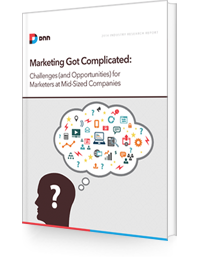
A couple of weeks ago, I attended the Forrester Forum in San
Francisco. Some of my colleagues attended Marketo Summit. The different themes at the conferences probably
all sound familiar – age of the customer, the customer is now in-charge, engage
with the customer ‘in context’, personalize – market to each person specifically
based on personal interests and context, integrated marketing – where all
applications work seamlessly together, branding is the same as customer
experience, etc.
There is nothing wrong with any of that. To be fair,
some of the sessions had great content. However, more than the
presentations – what got my attention was the informal conversations with both
fellow marketers and analysts; also, more than the content itself – what
intrigued me was what that meant to companies and the market; and finally
more than what was said – what got me thinking was what was left unsaid.
What do I mean?
1) Web Sites (other
than Google and Amazon) have become slower
Think about a typical web
site – it has content, but it also has software coming out of its ears. CMS, Social, Marketing Automation, Marketing
Optimization, Back-end integration to CRM and much more. Web Performance Today published an article that talks about
slowing web sites with clear proof points.
Are there exceptions? Sure. Amazon and Google come to mind.
2) Marketing has
become complicateD

Technology is supposed to
simplify things. It is supposed to help you understand your market
better, reduce costs, and increase revenue. Marketers tell us that
marketing has become way more complicated in the last 5 years. Why?
The answers were varied but centered around three themes:
- There
are too many technologies and systems;
- There
is far too much content; and
- There
are way too many ways to do online marketing.
Even larger enterprises are
struggling to figure out what and where to prioritize, and how to have an
overall-strategy to nirvana while ensuring sound operational execution.
For mid-sized and smaller companies the problem is further compounded due to
constrained resources and program dollars – they pretty much throw stuff
against the wall and see what sticks – this is an exaggeration but not by a
whole lot.
Nobody has the answers but
consulting firms, marketing services firms, and analysts are having a field
day.
3) Gathering data
is fine; Actionable insights are difficult and rare, even todaY
If you chart the buying
journey – from initial interest for your product to a visit to your web site to
engagement to leads to opportunities to dollars, there are probably 20
metrics. Now, if you add ‘context’ to the mix – where did the buyer come
from? What location were they at? What device were they using? Etc. You can go about 10 levels deep, for each of the 20 metrics.
If you add ‘program specific and time specific’ parameters – you can add a
third and sometimes a fourth dimension to the data.
IF you had all this data, you
would still need great data-professionals to scrub it to ensure it is valid
& authentic; and a data scientist to study and analyze it to come up with
the insights. The challenge though is that no single system captures all
this data – not even enterprise class systems have full and holistic
integration especially at the data layer level. That means the number of
marketing applications proliferates and you have a bunch of data-silos
compounding your challenge of being able to get real actionable insights.
The only system that seemed to
have both the breadth and depth to make this happen was from IBM – but even
that would need a ton of work, a ton of dollars and a ton of time to roll-out –
the system reminded me of the ERP systems of the 90s. This would cost
millions of dollars – at the low end.
So, most companies try to draw
boundaries, look at the data, infer to the best extent possible for a context –
and execute based on a combination of some data and a lot of subjective
judgment. There is nothing wrong with that – I am just saying that is
where things are.
4) Nurturing,
Scoring et al is fine – But, we will call everyone who visits uS
Everybody talks about data
and analytics. The companies that use it best today are consumer
companies. Most B2B companies (including the so called marketing
companies themselves) are so starved of leads that they have a low threshold and
begin calling or reaching out to even top of the funnel prospects with a sales
message.
With so much content, so much SEO/SEM spend, and so many companies out to get the consumer’s attention in so many
different channels – why should this be a surprise? This is reality. I
have received calls from SDRs at some leading marketing companies after ‘very
limited’ engagement on their web site (e.g. downloading a single white paper.
There is ‘no scoring,’ ‘nurturing’, or ‘algorithm’ here – it is basically
handing me off to the SDRs because you captured my contact information.
If you aren’t even able to eat your own dog-food ... Hmmm!).
5) The Internet Is
Not This Great Equalizer
There was a time when all
thought that the Internet had ‘democratized’ the world – and a 10 person shop
in Peoria with a web site could compete with anybody in the world as long as
they had good products and services because they could now be ‘reachable by
the world.’ Even if that time at all existed, it was only for a very
small time window. Today, everybody is on the web. That means
succeeding in business online is just as hard as it was offline – it is just
that the rules are different. The amount of software that you need to
have an effective online web presence today is mind-boggling.
6) No marketing
software vendor has delivered nirvanA
Case studies, customer
videos and testimonials aside – no marketing software vendor has been able to
deliver a complete solution that moves the needle. Why? Because it is too complicated. Because there are too many moving parts. Because not everything can be automated. Because not everything can be measured, scored and filed away. Because ...
7) Marketers have
less control than before and they are adjusting to that new reality
You can see who comes to your
web site. You can personalize your web
site. You can influence and guide
them. You can score them. You can MAKE them buy your product. Right? Wrong. The new reality is that
brands count for less. Loyalty doesn’t
matter. NPS scores are still important
but not as important as before.
Customers are more
independent minded than before. Fewer
customers replace their current car with a car from the same maker EVEN IF they
are satisfied with it. This is a big shift
in the last few years. This is the new
reality. Past performance counts way
less in a buyer’s purchase decision today.
8) Marketers spend
more today than before

Photo source: Chris Potter on
flickr.
Internet, Freemium, Try
before you buy, et al was supposed to reduce marketing expenses, and put
dollars back in the hands of the customer.Nothing could be further from the truth. Marketing spend has increased. The only change is that the ‘channels of spend’ are now different.
Google and Facebook are big
because of marketing spend. Thanks to
SEO, SEM, Social et al, the number of marketing consultants today is the
highest ever in marketing’s history. There are hundreds of software applications focused on marketing
today.
9) Personalization
has its limits
Software vendors would have
you believe that ‘personalization’ is the cure for cancer.
“You
are able to show the site visitor exactly what they want to see based on their
browsing history, their profile, and their origin.”
Nothing could be further from the truth. Preferences are labile. Consumers are human beings, which means that most
of them have limited self-insight.
In addition, their buying
behavior is influenced by others whom you don’t directly control. Also, you can never know everything about
them because that will raise privacy issues. Personalization can help you play the odds. Can you beat the odds? The jury is still out.
So, where do we go from here? I run a company that
sells marketing applications to the mid-market. So, I should know for
sure, right? I don’t know. Nobody does. But, here is my
perspective on:
How To Adapt To
The New Marketing Reality
1) Don’t buy
software because it is fashionable
Whether it is the CEO of a small
company who buys software because he can ‘show nice charts’ to the BOD, or the
CMO of a mid-sized company who buys software so he can justify his and his
team’s efforts to his peers and the CEO, that isn’t reason enough to buy.
Dig a level deeper. Ask
yourself exactly what you can do in real business terms without any software –
then ask yourself what you could do with something basic and simple – then ask
yourself what you could do with something that has even more features – then
ask yourself what a full scale enterprise system could do for you. If you
answer this honestly, at some point you will begin to see diminishing returns
for the investment and for the effort.
That will give you a sense of what
type of software to buy for your needs. Buying Lithium, Jive or Marketo
just because your peer has that same software OR because the salesperson sent
you a logo-list of companies in your vertical will be counter-productive.
Plenty of people have fallen prey to this. Some have been burned by
it. Some will be burned by it.
2) Don’t try to boil
the ocean

Photo source: Malcolm Manners on
flickr.
Yes, understanding your entire buyer’s journey and
having all that data would be great. You could make such great
recommendations, have such great insights that result in such rapid growth that
you would be better than a rock-star. The only problem? It is impossible.
Define a clear problem. Be very specific.
Make sure the solution to that problem has a definite ROI. Use software
to solve that specific problem in a clear and defined time-frame. Don’t
take the traditional approach of making an excel spreadsheet of features for
comparison – and end up buying the most expensive software there is in the
market because that vendor had ‘green’ in all the rows of your excel
sheet. That is passé. That is ineffective. That is how
purchasing managers buy things – not marketers, and not business professionals.
3) Have tight
time-lines for ROI
If you buy a piece of software and it takes many
months to even begin to use it, and many quarters to get a benefit – you are
off the wrong start. In today’s world, with technology and user
experience being what they are – rolling out a piece of software, seeing ‘some’
benefits and working on increasing the benefits incrementally shouldn’t be that
hard. If it is that difficult – it is more likely because the vendor
operates on the traditional ERP-based enterprise software model than as a
modern software company.
4) Data Nirvana
takes time
Data Nirvana can and should be your true
north. That should be your vision – but you also need strategy,
shorter-term prioritization and execution.
You may never achieve data
nirvana. Even if you do, it will likely
take you way too long. The key is to use
data to ‘experiment’ and ‘iterate’. Use
data for small, defined and closed experiments without worrying about
connecting the dots completely. That
way, the data is both immediately useful, and if you do connect the dots
completely – it is useful again, making it a double victory.
5) Focus on
‘others’ – i.e. not just your potential buyers but the people who influence
your buyers
People increasingly are making decisions based on
what ‘others’ are saying about the product they are looking to buy. Way more people look at Yelp before going to
a restaurant than ever before. Way more
people look at Angie’s list reviews before calling plumber. Way more people are looking at a LinkedIn
profile (including recommendations) before interviewing a candidate. What started with B2C is slowly moving to
B2B. It is therefore imperative that you
as a vendor focus on the ‘others’ that people will reference before they even
talk to you.
6) You don’t have
control: Get over iT
Irrespective of how much technology you buy,
implement and use – the current reality makes it very difficult for you to
directly control the market. Focus on
what you can do to influence the market, and influence buyers. This world is more abstract. It is more superfluous (despite OR perhaps
because of all the instrumentation and the data). The more you are used to it – the more
comfortable you will be – and the better you will perform as a marketer.
7) Be suspicious of
enterprise software that costs an arm and a leg
Some people seem to be trying to re-invent the 90s
ERP era. That era is long gone. Be suspicious of any software that costs too
much, takes too long to get going, and promises to move heaven and earth. Buy software that is easy to use and doesn’t
require too much training, that can be deployed in a reasonable amount of time,
and provides you some positive results quickly. If the nature of the software OR the problem is such that it takes a big
investment in time – take care to break down the project (and your dollar
investments), define clear milestones and manage it very very carefully.
Related Research Report

We've published a related research report, "Marketing Got Complicated: Challenges (and Opportunities) for Marketers at Mid-Sized Companies." Register for
your complimentary copy.